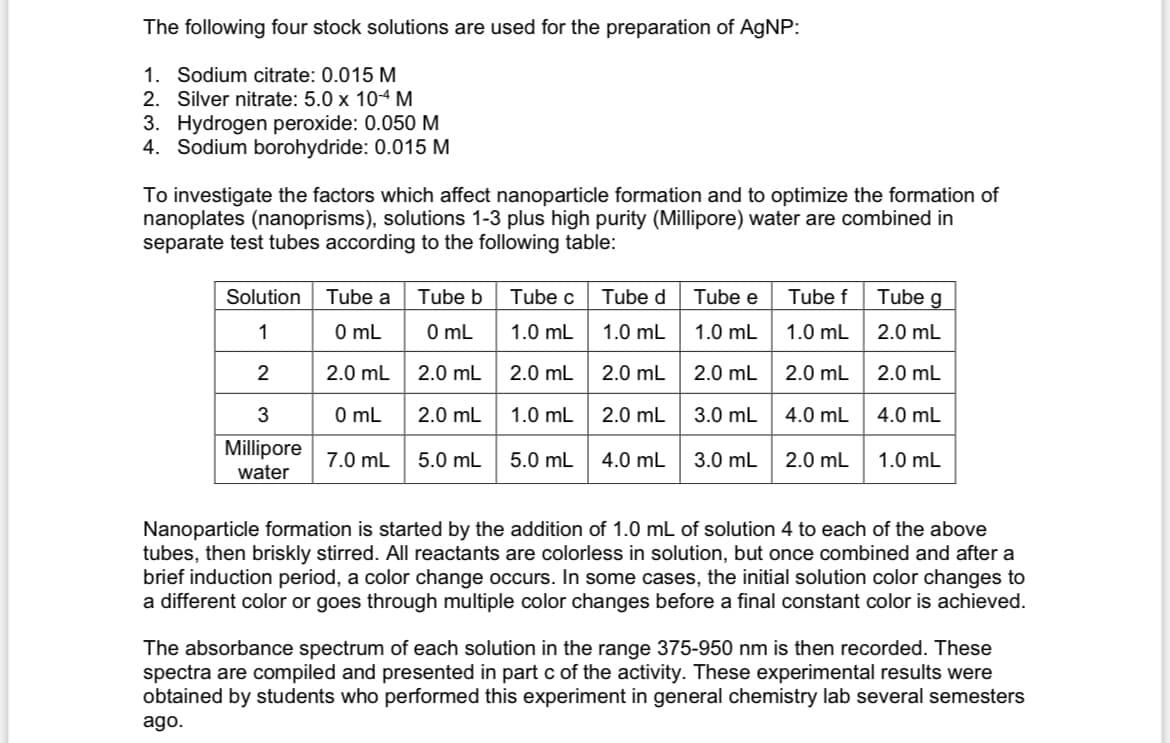A1. Sodium citrate: 0.015 M. Calculate the mass of sodium citrate dihydrate, Na3C6H5O7(H2O)2, needed to prepare 25 mL of a 0.015 M sodium citrate solution. A2. Silver nitrate: 5.0 x 10-4 M. Calculate the volume of 0.040 M AgNO3 solution needed to prepare 50 mL of 5.0 x 10-4 M AgNO3 solution. a3. Hydrogen peroxide: 0.050 M. Calculate the volume of 1.2 M H2O2 solution needed to prepare 50 mL of 0.050 M H2O2 solution. a4. Sodium borohydride: 0.015 M. Calculate the volume of 0.25 M NaBH4 solution needed to prepare 25 mL of 0.015 M NaBH4 solution.
A1. Sodium citrate: 0.015 M. Calculate the mass of sodium citrate dihydrate, Na3C6H5O7(H2O)2, needed to prepare 25 mL of a 0.015 M sodium citrate solution. A2. Silver nitrate: 5.0 x 10-4 M. Calculate the volume of 0.040 M AgNO3 solution needed to prepare 50 mL of 5.0 x 10-4 M AgNO3 solution. a3. Hydrogen peroxide: 0.050 M. Calculate the volume of 1.2 M H2O2 solution needed to prepare 50 mL of 0.050 M H2O2 solution. a4. Sodium borohydride: 0.015 M. Calculate the volume of 0.25 M NaBH4 solution needed to prepare 25 mL of 0.015 M NaBH4 solution.
Chemistry
10th Edition
ISBN:9781305957404
Author:Steven S. Zumdahl, Susan A. Zumdahl, Donald J. DeCoste
Publisher:Steven S. Zumdahl, Susan A. Zumdahl, Donald J. DeCoste
Chapter1: Chemical Foundations
Section: Chapter Questions
Problem 1RQ: Define and explain the differences between the following terms. a. law and theory b. theory and...
Related questions
Question
100%
A1. Sodium citrate: 0.015 M. Calculate the mass of sodium citrate dihydrate, Na3C6H5O7(H2O)2, needed to prepare 25 mL of a 0.015 M sodium citrate solution.
A2. Silver nitrate: 5.0 x 10-4 M. Calculate the volume of 0.040 M AgNO3 solution needed to prepare 50 mL of 5.0 x 10-4 M AgNO3 solution.
a3. Hydrogen peroxide: 0.050 M. Calculate the volume of 1.2 M H2O2 solution needed to prepare 50 mL of 0.050 M H2O2 solution.
a4. Sodium borohydride: 0.015 M. Calculate the volume of 0.25 M NaBH4 solution needed to prepare 25 mL of 0.015 M NaBH4 solution.

Transcribed Image Text:The following four stock solutions are used for the preparation of AGNP:
1. Sodium citrate: 0.015 M
2. Silver nitrate: 5.0 x 104 M
3. Hydrogen peroxide: 0.050 M
4. Sodium borohydride: 0.015 M
To investigate the factors which affect nanoparticle formation and to optimize the formation of
nanoplates (nanoprisms), solutions 1-3 plus high purity (Millipore) water are combined in
separate test tubes according to the following table:
Solution
Tube a
Tube b
Tube c
Tube d
Tube e
Tube f
Tube g
1
O mL
O mL
1.0 mL
1.0 mL
1.0 mL
1.0 mL
2.0 mL
2
2.0 mL
2.0 mL
2.0 mL
2.0 mL
2.0 mL
2.0 mL
2.0 mL
O mL
2.0 mL
1.0 mL
2.0 mL
3.0 mL
4.0 mL
4.0 mL
Millipore
water
7.0 mL
5.0 mL
5.0 mL
4.0 mL
3.0 mL
2.0 mL
1.0 mL
Nanoparticle formation is started by the addition of 1.0 mL of solution 4 to each of the above
tubes, then briskly stirred. All reactants are colorless in solution, but once combined and after a
brief induction period, a color change occurs. In some cases, the initial solution color changes to
a different color or goes through multiple color changes before a final constant color is achieved.
The absorbance spectrum of each solution in the range 375-950 nm is then recorded. These
spectra are compiled and presented in part c of the activity. These experimental results were
obtained by students who performed this experiment in general chemistry lab several semesters
ago.
Expert Solution
This question has been solved!
Explore an expertly crafted, step-by-step solution for a thorough understanding of key concepts.
This is a popular solution!
Trending now
This is a popular solution!
Step by step
Solved in 6 steps

Knowledge Booster
Learn more about
Need a deep-dive on the concept behind this application? Look no further. Learn more about this topic, chemistry and related others by exploring similar questions and additional content below.Recommended textbooks for you

Chemistry
Chemistry
ISBN:
9781305957404
Author:
Steven S. Zumdahl, Susan A. Zumdahl, Donald J. DeCoste
Publisher:
Cengage Learning

Chemistry
Chemistry
ISBN:
9781259911156
Author:
Raymond Chang Dr., Jason Overby Professor
Publisher:
McGraw-Hill Education

Principles of Instrumental Analysis
Chemistry
ISBN:
9781305577213
Author:
Douglas A. Skoog, F. James Holler, Stanley R. Crouch
Publisher:
Cengage Learning

Chemistry
Chemistry
ISBN:
9781305957404
Author:
Steven S. Zumdahl, Susan A. Zumdahl, Donald J. DeCoste
Publisher:
Cengage Learning

Chemistry
Chemistry
ISBN:
9781259911156
Author:
Raymond Chang Dr., Jason Overby Professor
Publisher:
McGraw-Hill Education

Principles of Instrumental Analysis
Chemistry
ISBN:
9781305577213
Author:
Douglas A. Skoog, F. James Holler, Stanley R. Crouch
Publisher:
Cengage Learning

Organic Chemistry
Chemistry
ISBN:
9780078021558
Author:
Janice Gorzynski Smith Dr.
Publisher:
McGraw-Hill Education

Chemistry: Principles and Reactions
Chemistry
ISBN:
9781305079373
Author:
William L. Masterton, Cecile N. Hurley
Publisher:
Cengage Learning

Elementary Principles of Chemical Processes, Bind…
Chemistry
ISBN:
9781118431221
Author:
Richard M. Felder, Ronald W. Rousseau, Lisa G. Bullard
Publisher:
WILEY